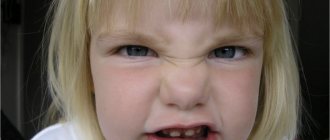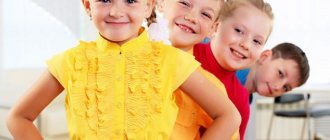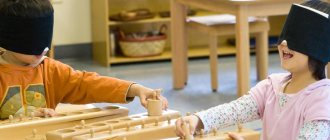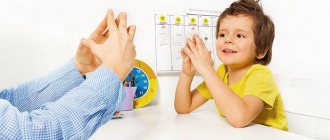Creative abilities of preschool children
Creative abilities, like intellectual ones, belong to the group of cognitive abilities. Only the main load falls on various cognitive processes. In intellectual cognition, thinking plays a leading role, and in creative cognition, imagination plays a leading role. Therefore, the creative abilities of preschoolers begin to develop later - in the second half of preschool childhood.
A child can try on pyramid rings to fit them to size as early as two years of age. This indicates his intellectual development. But a preschooler will be able to see a new image in the same pyramid, calling it “girl”, “slide”, etc., when he receives numerous ideas about the world, comprehends analogies and activates his imagination.
The creative abilities of preschool children are an original approach to understanding the environment, a tendency to find non-standard ways and means of solving problems, and a desire to obtain original results.
Children can realize their creative potential in any type of activity. By drawing or constructing a structure, performing actions with toys, or being carried away by role-playing games, preschoolers are guided by their plan. Since the plan is formed on the basis of how the child perceives the surrounding reality, it can reflect a typical picture, but it can also be very unusual.
Directions for the development of children's creative abilities
Creativity rarely develops on its own. Their development needs stimulation. For this reason, it is important to know in what directions the creative abilities of preschoolers can be developed. There are two effective lines:
- Complicating actions in using means to implement plans
- Expanding the set of tools to solve a specific problem
As an example, consider how children use a bucket. In addition to its direct purpose, it can serve as a form for Easter cakes, the upper part of a constructed tower, a headdress, a chair, a support for a bridge, etc. But children come to this variability with the development of creativity.
The same goes for finding new means to realize your ideas. You cannot draw an outline - a preschooler will lay it out with sticks; no sticks - will line up cubes around the perimeter; there are no cubes - he will stretch out a jump rope or a strap... If there are no more or less suitable means, the older preschooler will act in imaginary circumstances.
Every time the search for suitable means and possibilities for their use is a kind of brainstorming for the creative thinking of a preschooler. Experience confirms that the most original ideas come AFTER trying more familiar options. It is important for adults to remember this fact and encourage the child’s activity in generating new ideas.
Unique talents of children
When listing what a preschool child is capable of, it should be noted that some children’s skills can be extremely unusual and rare. These skills seem to come out of nowhere. They open suddenly, no one specifically tried to develop them. Nature has endowed selected children with the inclinations of such a high degree of development that they begin to manifest themselves in the first years of life.
There are well-known composers and poets in society who wrote their first works at the age of five. There are 3-year-old children who play chess so successfully that adults lose to them.
There are children with unusual abilities who memorize large texts on the fly or easily operate with numbers, carrying out addition, subtraction and multiplication operations with multi-digit numbers in their minds.
It is important that parents of such gifted children do not go to extremes - do not perceive the outstanding abilities of their children as fun, or do not strive to develop exclusively this side of the child to the detriment of others. For example, having phenomenal counting skills, it is not so important to perform the functions of a calculator. It is much more important to develop mathematical abilities, which are much more multifaceted than arithmetic operations, albeit with complex numbers.
Features and signs of development of creative abilities of preschool children
The preschool period is especially favorable for the development of artistic and creative abilities.
The child gets acquainted with visual and constructive activities, pays attention to the musicality of the surrounding world, and tries his hand at creating drawings, crafts and buildings.
A clearly expressed cognitive need of a preschooler is a sign of creative potential. In addition, abilities for various types of artistic activity have specific characteristics. It is useful for parents to know how children's inclinations in certain creative areas manifest themselves.
Signs of creative abilities of preschoolers in art activities
The very way and what means a child chooses to realize his plan indicates the presence or absence of a creative approach. A few more telling signs about the presence of abilities in visual arts:
- A preschooler prefers drawing or modeling as soon as he has a choice of what to do.
- As part of the plot, it depicts a large number of objects and people.
- He chooses original subjects for his drawings. For example, he does not depict the usual house-tree-flowers, but paints a sky strewn with stars around a shining sun, and calls his picture Cosmos.
- Resorts to drawing or sculpting to express his mood and feelings.
- He uses new material with interest to implement his plans, and is also eager to try out a new medium in practice (sculpt from clay, not plasticine; draw with paints instead of pencils).
- Shows interest in works of painting and sculpture - examines, speaks out about the painting or statue he sees.
Creative talent in theatrical activities
Attentive adults notice artistic talent in a child from early preschool age, as soon as the child develops speech skills. Later, nonverbal expression comes into play, complementing the expressive signs of artistry.
- Likes to imitate colorful characters from fairy tales and cartoons, trying to convey the tone of speech and characteristic movements.
- He easily takes on any role, imagining himself either as a friendly dog, or as a dangerous wolf, or as a Wizard.
- Actively uses facial expressions, gestures and movements to convey the feelings and character of the image.
- Seeks to evoke an emotional response in others when telling something or portraying a character.
- Uses attributes (appropriate clothing, distinctive supporting details) to emphasize his suitability for the role.
- He enthusiastically watches children's performances, be it a theatrical game or a puppet show.
Signs of abilities for speech creativity in preschool age
What features should adults look for in order to notice the makings of literary talent in a preschooler:
- The child listens carefully to fairy tales and children's stories. At some plot points he stops the narrator and asks clarifying questions.
- Can compose a story himself, observing the key structure: a semblance of a plot plot, a climactic event and a final moment. For younger preschoolers, such stories can literally consist of 4-5 sentences, but the structure of the story can be traced.
- Comes up with something original when he retells a well-known story or fairy tale.
- When talking about something, he adheres to the storyline and main idea.
- Uses words that convey the experiences and feelings of the characters.
- He explains some points in particular detail so that listeners understand what is happening.
Creating conditions for the development of creativity
Every year, the ideas and actions of a preschooler improve and become more complex. Creative abilities develop in close connection with imagination. Even without external pushing, a child is interested in discovering new horizons of his achievements. And if he is additionally carefully directed to search for non-standard solutions, the results will become original.
Developing creativity through story writing
Without creativity, it is impossible to compose your own story. After all, the child needs to extract from memory suitable characteristics for invented characters, place them in imaginary circumstances and fantasize the actions of his heroes.
To create images you need material. The more of it there is in a child’s memory, the more variably the child will use it.
Parents stimulate the development of creative abilities in preschoolers if they not only read and tell them fairy tales and other children's works, but also encourage them to write:
- How would everything have happened if the main character had acted differently?
- What magical object would be useful to the hero of a fairy tale, and how would it help him?
- How differently could the story have ended?
Questions like these encourage children to first modify and add to existing works, and then create their own stories.
Construction as a means of developing creativity
Direct activation of creative abilities occurs in the process of constructive activity. If we keep in mind construction design, then children rarely build the same objects. They conceive new buildings, find new ways to implement their ideas.
In addition, during the process, the young builder can change his plans several times. As a result, its design acquires new details, improves, and changes its purpose.
It is imperative to ask the preschooler what he built, what the structure is intended for, how to use it, how it differs from the previous one, etc.
Paper design is an unlimited field for creativity. For a child, this type of creative activity becomes available in older preschool age with the development of manual skill. A complex type that is implemented at the suggestion of an adult and with his leading role.
At first, the child only observes what an ordinary sheet of paper can turn into in skillful hands, then he tries to repeat it with the direct participation of an adult. And only older children try to design the product themselves.
Adjusting the settings: psychological attitudes that will help develop creativity
Before moving on to practical recommendations, I want to pay due attention to psychological settings. Let's talk about how you need to perceive creativity and yourself in it, how to relate to it, what to expect. And at the same time, we’ll dispel some harmful myths about creativity.
Creativity is accessible to everyone
In the minds of some people, stereotypes from 50 years ago still dominate, according to which creativity is the preserve of a select few. Allegedly, a person’s fate is predetermined by genes, physiological characteristics and other immutable prerequisites. And if, for example, a child at the age of 5 does not demonstrate perfect pitch, then the path to becoming a musician is closed to him.
More than 100 cool lessons, tests and exercises for brain development
Start developing
However, this myth has long been dispelled by numerous scientific studies. Scientists loudly declare that creative abilities can and should be developed. And you can do this at any age. Of course, there are people who are naturally endowed with creative inclinations. But these inclinations should be viewed not as an indisputable advantage, but as a small head start.
Imagine that you are going to participate in a marathon. Among the participants there are several people who have a head start. The starting line for them is shifted several tens of meters forward. Will this handicap guarantee victory at the finish line? Of course not. Much more important is the training of athletes, their strong-willed qualities and desire to win.
The situation is the same in any other matter. Perseverance, determination, and self-discipline outweigh natural inclinations. And that's great! This means that a person can completely create himself and confirm the title of the crown of nature.
I suggest reading the article about what motivation is. After all, without this component of personality it is impossible to effectively engage in self-development.
Creativity does not need to be “awakened”
“Awaken creativity” is a fundamentally incorrect and harmful expression. It gives the impression that within every person these abilities already exist and you just need to dig deep within yourself to find them.
This is the same as believing that every person has the ability to read. We know that this is not so. In fact, we only have tools with which we can achieve the development of any skill or ability, including creative abilities. These are our neurons and brain hormones that are responsible for higher nervous activity.
Any skill is a system of neural connections formed in the process of activity. The denser and more branched this system is, the higher the person’s skill in a particular matter. Therefore, no amount of dancing with tambourines or special rituals can awaken your creative abilities. They can only be created by ourselves through long, focused and fruitful work.
The role of the family in the development of creative abilities of preschool children
Who, if not the parents, is obliged to notice what the child is more drawn to, what his capabilities are in a particular period, and on the development of what abilities it is important to focus the main attention.
Of course, a preschooler’s personality should be enriched in different directions - teaching drawing and modeling, designing and inventing stories together, organizing a simple home theater. In each of these types of activities there is room for the transformation of reality and the manifestation of creative abilities.
Most children do not have a special interest in all types of activities, but highlight priority ones for themselves. It is in this field that parents should create conditions so that the child discovers new means and expands the options for using them to realize his plans. Directed efforts of loving and understanding adults, unobtrusive participation in children's games and activities can and should be used to develop the creative abilities of preschoolers.







